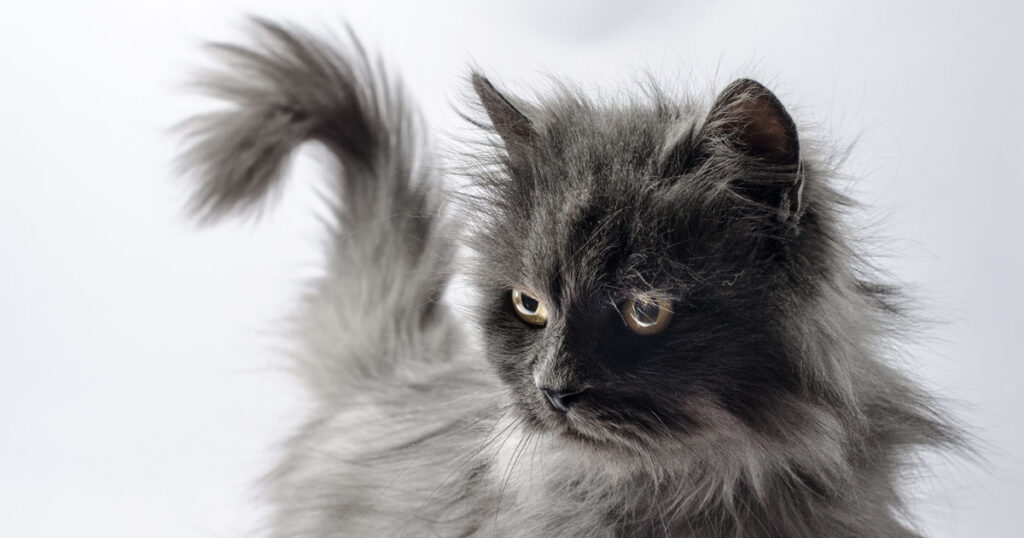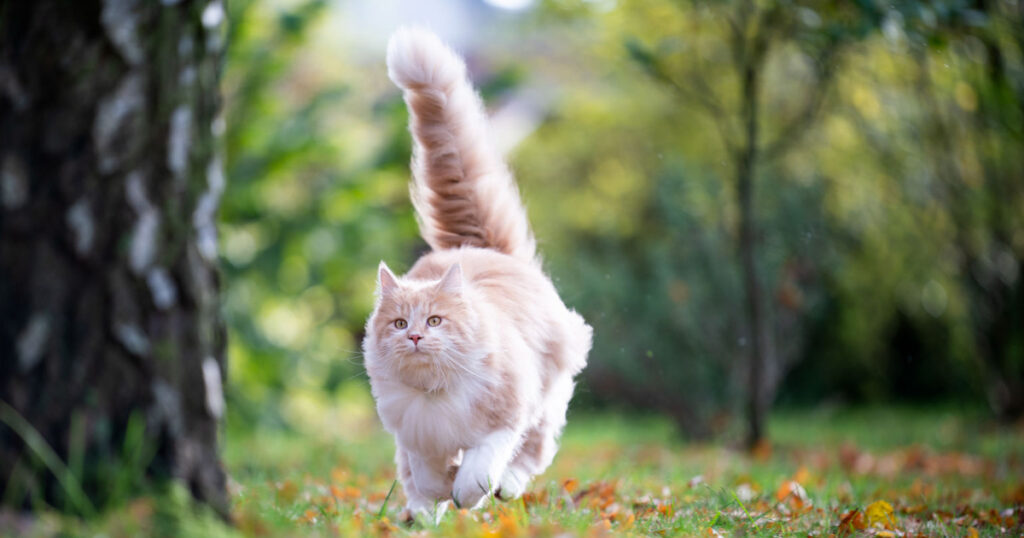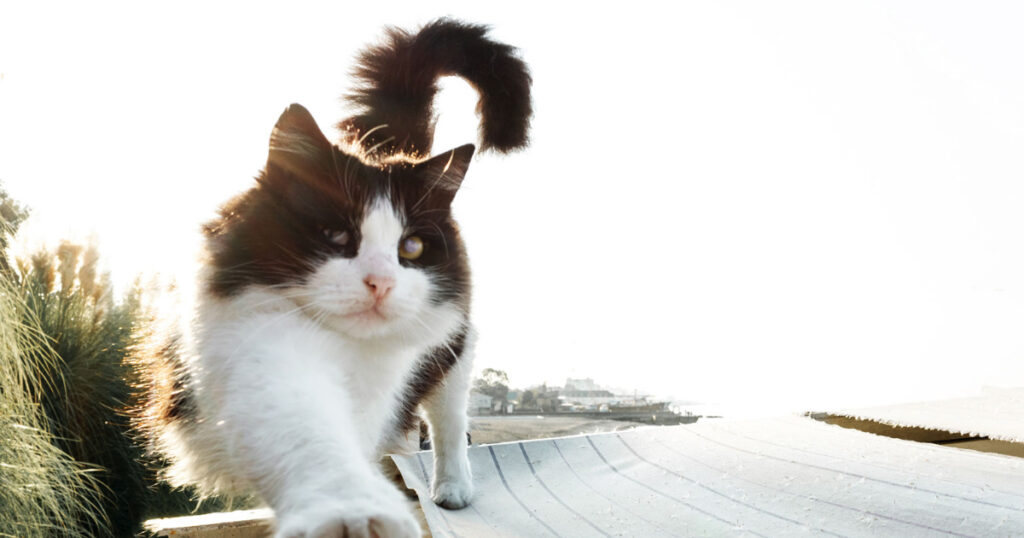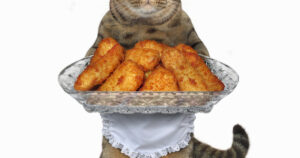If you love cats, you know they have many ways to show their feelings and moods with their body language.

One of the most important parts of their body language is their tail. Cats use their tails to communicate different emotions and messages, and if you can understand these signals, you can have a better relationship with your cat.
Cats have different tail positions and movements that express their feelings or wants.
Tail Position: High
A high tail means your cat feels confident, happy, and relaxed. You might see this position when your cat greets you or another cat they like. It means they are friendly and open to interaction.

A high tail can also mean your cat is exploring a new place and feeling safe and curious. Sometimes, the tip of the tail might curve slightly, which shows your cat is in a playful and fun mood.
Tail Position: Curved Like a Question Mark

This tail position is fascinating and mysterious. It means your cat is curious, interested, or playful.
Your cat may curl their tail like this when happy and relaxed. They may want to interact or play with you or other cats.
But you should also look at their ears and eyes to understand their feelings.
Tail Position: Low

A low tail means your cat is angry, scared, or submissive. Your cat may lower their tail when they face a threat or feel unsafe.
You should give your cat space and avoid loud noises or sudden movements.
Some cat breeds naturally have low tails, so consider your cat’s breed and personality too.
Tail Position: Tucked Away
Your cat may hide their tail under their body when they feel scared, nervous, or submissive.
This means they want to look smaller and less threatening to something frightening or intimidating.
You can help your cat feel more confident and secure by giving them a safe space and comfort.
Tail Position: Puffed Up
Your cat may fluff their tail when feeling frightened, threatened, or angry. This happens when something startles or annoys them, and they want to look bigger and more scary to scare it away.
You can help your cat calm down by giving them space and time and avoiding anything that might upset them more.
Tail Position: Whipping Motion
Your cat is upset if their tail lashes back and forth quickly. They may also show other signs of irritation, like flat ears or big eyes.

Give your cat some space, and don’t touch them when they act like this. Wait until they calm down.
Tail Position: Swishing Motion
Your cat’s tail may sway slowly from side to side for different reasons. Sometimes, this means your cat is happy and relaxed.
Other times, it means your cat is annoyed or unsure.
Look at your cat’s face and body to know how they feel.
Tail Position: Wrapped Around Another Cat
Cats show their affection and friendship by wrapping their tails around each other. This is like a human hug and means they trust and like each other.
If your cat does this to you, they love and feel close to you. You have a strong bond with your cat.
FAQs
What makes some cats’ tails curl and others’ straight?
A gene mutation causes some cats to have curly tails. The mutation changes the shape and length of their tail bones.
A cat needs two copies of this gene, one from each parent, to curl its tail. Otherwise, it will have a straight tail.
Only a few cat breeds and mixed breeds have curly tails. Some examples are the Japanese Bobtail, the American Ringtail, the Devon Rex, and the Siamese.
Curly tails do not harm cats or affect how they act. They are just a special and cute trait that makes them different from other cats.
Can a cat’s tail change its shape as it grows?
Many things can change a cat’s tail shape as it grows, such as age, injury, disease, or grooming.
For instance, a cat’s tail may get thinner or shorter when it gets older or lose some hair due to shedding.
But a cat’s tail cannot change from straight to curly or vice versa as it grows. The genes decide the shape of a cat’s tail, and the environment cannot change that.
A cat with a straight tail will always have a straight tail, and a cat with a curly tail will always have a curly tail.
Is a curled tail a health issue for cats?
No, a curled tail is not a health issue for cats. It is a natural variation that comes from genetics. It does not mean the cat has any health problems.
Which cat breeds have unique curled tails?
Several cat breeds have unique curled tails. Here are some examples:
- Japanese Bobtail: This breed has a short, kinked tail resembling a pom-pom. It can curl over the back or spiral. The Japanese Bobtail is an old and popular breed in Japan and is considered lucky.
- American Ringtail: This breed has a long, flexible tail that curls into a ring over the back or side. It can also loop or corkscrew. The American Ringtail is a new and rare breed developed from a curly-tailed stray cat found in California in 1998.
- Devon Rex: This breed has a slender, wavy tail that can slightly curl at the tip. The Devon Rex is known for its large ears, curly coat, and playful nature. It originated from a curly-haired kitten born in England in 1959.
- Siamese: This breed has a long, tapering tail that can curve slightly at the end. The Siamese is known for its pointed coat color, blue eyes, and vocal nature. It’s one of the oldest and most popular breeds worldwide, originating from Thailand (formerly Siam).
How can I help my cat have a healthy tail?
Here are some tips to help your cat have a healthy tail:
- Give your cat a balanced diet to meet its nutritional needs and prevent obesity.
- Provide fresh water at all times to keep your cat hydrated.
- Groom your cat regularly by brushing its fur and trimming its nails.
- Check your cat’s tail for injuries, infections, parasites, or mats.
- Keep your cat indoors or supervise it outdoors to prevent accidents or fights with other animals.
- Give your cat toys and scratching posts to stimulate physical and mental activity.
- Don’t pull or twist your cat’s tail or use it as a handle.
- Show your cat love and affection by petting and cuddling its body and tail.
Conclusion
To have a good relationship with your cat, you need to know what their tail positions mean.
We explained some of them, like the question mark tail. This will help you understand your cat’s feelings and wants and make them happy and loved.








